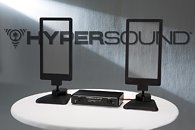Thursday, June 9th 2016

Turtle Beach Announces the HyperSound Glass
Turtle Beach Corporation, a leading audio technology company for over 40 years, has achieved another significant breakthrough with its HyperSound technology, as the company revealed today it is now able to create directional audio using a transparent pane of glass. The Company's latest innovation opens the doors for exploration into future glass-based directional audio products and applications in the consumer, commercial and hearing healthcare spaces.
"The advancements the HyperSound team is making with directional audio are simply amazing - some of the biggest breakthroughs in audio technology to come along in decades," said Juergen Stark, CEO, Turtle Beach Corporation. "Being able to create highly directional audio using glass opens up many potential opportunities, including integrating into desktop monitors, commercial displays, desktop speakers, and automotive dashboard glass to provide warnings directed specifically at the driver… pretty much anywhere there's glass there's a potential for audio. As we progress the technology, this also opens up licensing possibilities to external parties looking for ways to integrate the latest audio technology into their products. Again, it's still early in development and the applications are simply ideas on the drawing board, but at the same time having HyperSound directional audio working on glass is very exciting and we can't wait to show it publicly for the first time at E3."HyperSound technology is a fundamentally new approach to sound delivery that generates a highly directional, narrow beam of audio in the air. Similar to how a flashlight directs a beam of light, HyperSound directs a beam of audio to targeted listeners in a specific spot, delivering an immersive, 3D-like audio experience. HyperSound Glass is similar in design to touchscreen glass, where there are multiple layers of transparent materials and electronics working in conjunction with the glass. For HyperSound Glass, the glass pane is layered with a set of transparent films allowing it to generate abeam of ultrasound that delivers crisp, clear audio to the targeted listener.
"The advancements the HyperSound team is making with directional audio are simply amazing - some of the biggest breakthroughs in audio technology to come along in decades," said Juergen Stark, CEO, Turtle Beach Corporation. "Being able to create highly directional audio using glass opens up many potential opportunities, including integrating into desktop monitors, commercial displays, desktop speakers, and automotive dashboard glass to provide warnings directed specifically at the driver… pretty much anywhere there's glass there's a potential for audio. As we progress the technology, this also opens up licensing possibilities to external parties looking for ways to integrate the latest audio technology into their products. Again, it's still early in development and the applications are simply ideas on the drawing board, but at the same time having HyperSound directional audio working on glass is very exciting and we can't wait to show it publicly for the first time at E3."HyperSound technology is a fundamentally new approach to sound delivery that generates a highly directional, narrow beam of audio in the air. Similar to how a flashlight directs a beam of light, HyperSound directs a beam of audio to targeted listeners in a specific spot, delivering an immersive, 3D-like audio experience. HyperSound Glass is similar in design to touchscreen glass, where there are multiple layers of transparent materials and electronics working in conjunction with the glass. For HyperSound Glass, the glass pane is layered with a set of transparent films allowing it to generate abeam of ultrasound that delivers crisp, clear audio to the targeted listener.

24 Comments on Turtle Beach Announces the HyperSound Glass
Can it handle high volumes with minimal distortion?
Curved glass should allow the sound to be heard over a larger area.
Also HyperSound mentioned a potential use for positional audio in VR, but considering that the sound is highly directional, you will have to use it alongside traditional speakers (which will add up to whoknowshowmanydollarbills).
A good explanation of the tech:
www.explainthatstuff.com/directional-loudspeakers.html
Where you can already buy some ultrasonic speakers:
www.soundlazer.com/what-is-a-parametric-speaker/
This is how you make extraordinary glass speakers. Greensound Glass speakers. They do cost a lot of money, but just look at them. I think I just came a bit...
I was even thinking of designing classic membrane speakers with glass middle cone and speaker casing. Basically, the driver would be still the same, but made of super thin glass center for good response since it needs to be light and thick glass housing. The reason for this is that glass resonates with the sound opposed to wooden housing muffling it. This should at least in theory create far more detailed and clear sound.
besides, there are way cooler stuff made around those things, like vaporing water with just a couple of milliamps, etc.
here is something way more interesting with piezos in it, that comes in truck loads from china and can be bought in for a few american pesos, with no need for fancy glass around it mind you
Which actually kick ass but very pricey. Best speakers I have ever head were thin ES speakers and about 6' tall with tube amp in like 1985